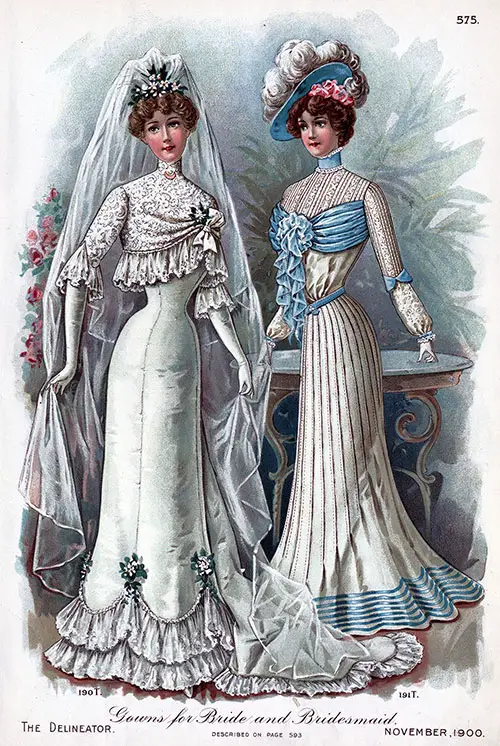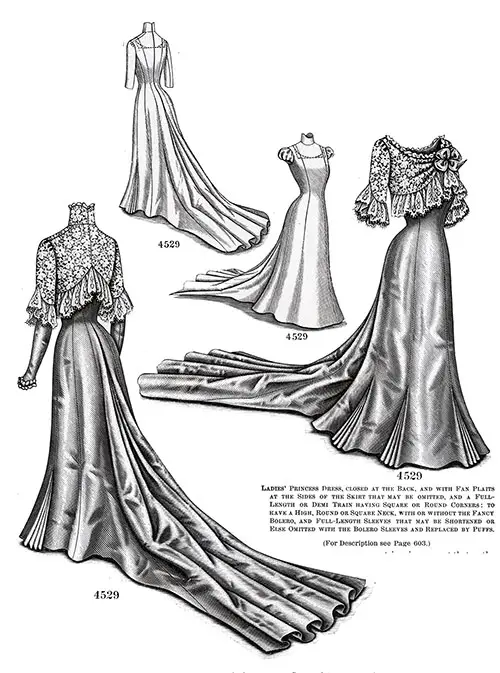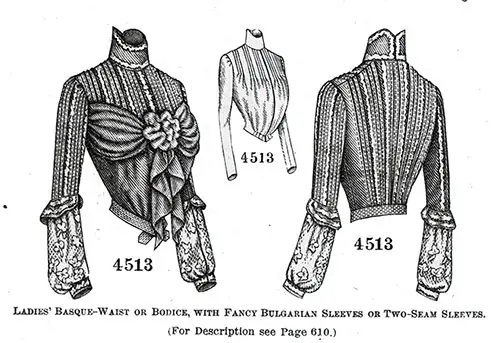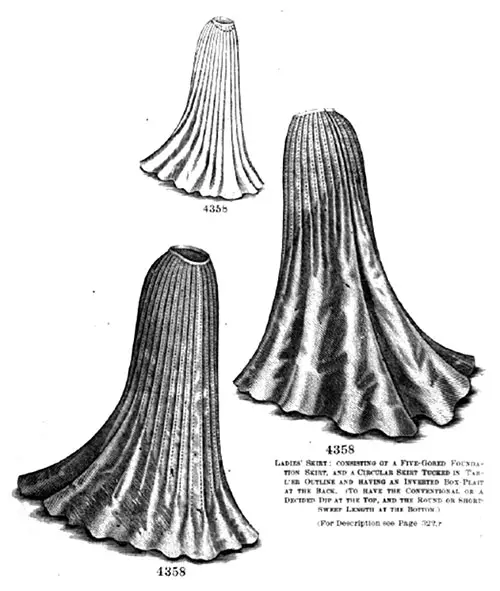Brides and Bridesmaid Dresses 190 T & 191 T - 1900

Ladies' Princess Wedding Dress No. 190 T
A more elegant wedding gown could scarcely be desired than the one portrayed here, developed in ivory white satin and all-over lace. Frills of lace, white satin ribbon, and sprays of orange blossoms are employed as garniture. The dress shows the faultless adjustment which distinguishes the princess modes.
The fancy bolero, which contributes significantly to the attractiveness of the design, is curved gracefully to be quite shallow at the center of the back and caught up at the left side in front to produce a draped effect.
The full-length sleeves are omitted, and the bolero sleeves are finished at their fancy lower edge with a frill of lace. Similar embellishments outline the bolero and are arranged about the bottom of the skirt, which may be made with a full-length or demi-train.
The high stock is deepest at the sides, and the long tulle veil is held in place by a wreath of orange blossoms.
Dressmaker Options
Crêpe de Chine and voile are also used for wedding gowns and would reproduce the mode prettily combined with accordion-plaited and tucked chiffon.
Pattern Information
The pattern, which is No. 4529 and costs is or 30 cents, is in six sizes for ladies from thirty-two to forty-two inches, bust measure, and is again shown on page 592.
Ladies’ Princess Dress No. 4529

No. 4529 Ladies’ Princess Dress, closed at the Back, and with Fan Plaits at the Sides of the Skirt that may be omitted, and a Full- Length or Demi Train having Square or Round Corners: to have a High, Round or Square Neck, with or without the Fancy Bolero, and Full-Length Sleeves that may be Shortened or Else Omitted with the Bolero Sleeves and Replaced by Puffs.
Description on Page 603 | Illustrated on Page 592
Description
This dress is represented on page 592, and at figures Nos. 188 T and 190 T in this number of The Delineator.
Among other noteworthy features of this beautiful princess dress may be mentioned the fancy bolero.
The mode is one having many intriguing possibilities and is especially desirable for developing wedding gowns, and also for wear at high social functions, or upon occasions when ceremony demands that the dress be low-necked.
The dress as shown is made of Eolienne in one of the pastel hues of mauve combined with all-over white lace and decorated with lace edging, appliqué and ruches of chiffon, closes at the back and shows the graceful adjustment that characterizes the princess modes.
It may be made with high, round, or square neck and with full-length or demi-train having rounded or square corners, and when made high-necked is finished with a standing collar that is deepest at the sides.
The bolero is shaped with shoulder and small under-arm seams, and at the lower edge, the back is cut fancifully, the front being caught up prettily a little to the left of the center under a bow of satin ribbon.
The close-fitting two-seam sleeve may be in full-length style extending over the hand, or in elbow length, or it may be omitted and the one-seam bolero sleeve, that ends above the elbow, where it is fancifully shaped, substituted.
The long sleeves and bolero sleeves may be used together if desired, and the pattern also provides for a short puff sleeve. At the lower part of the front and side-front seams a fan-plaited section is introduced, giving extra Hare at the foot, but it may be omitted.
Below the waistline at the back extra fulness is allowed and arranged in an under-folded double box-plait that falls out into the train, which, in the full length, measures about two yards and one-fourth from a little below the waist-line to the lower edge.
Dressmaker Options
A wedding gown of Irish poplin combined with Irish point lace trimmed with ribbon or ruchings and the conventional orange blossoms will be decidedly handsome.
Ivory satin is much used for wedding gowns, and a dress developed in this luxurious fabric with tucked chiffon edged with lace appliqué for the bolero would be very attractive.
Nun’s-vailing, Liberty cloth, etc., are also suitable fabrics, and panne velvet could be used for the bolero.
Pattern Information
We have pattern No. 4529 in six sizes for ladies from thirty-two to forty-two inches, bust measure.
For a lady of medium size, the dress with full-length train needs eight yards and three-fourths of fabric forty-four inches wide; the dress with demi-train needs seven yards and seven-eighths of material in the same width, with a yard and one-half of all-over lace eighteen inches wide for the collar and bolero.
Price of pattern, 1s. or 80 cents.
Ladies' Basque-Blouse and Skirt No. 191 T

Mode and a contrasting shade of blue crêpe de Chine and velvet are here united in this costume, with figured white chiffon for the lower part of the sleeves.
The basque-blouse is distinguished by groups of tucks that extend from the neck to the lower edge at the back and deep yoke depth at the front.
Between each group of tucks, a band of insertion is arranged, and a graceful effect is produced by full drapery portions that meet in a large chou at the bust.
A narrow belt with crossed ends follows the lower edge of the blouse and emphasizes the dip at the front. The sleeves, which are in Bulgarian style, have the upper part tucked to harmonize with the waist proper, while the full under-portions are completed with wristbands and topped by fanciful cuffs.
The skirt, in short-sweep length, is of circular shaping and is tucked in tablier outline, an under-folded box-plait disposing of the fulness at the back. It is made with a becoming dip at the top and has a live-gored foundation with rows of narrow blue velvet ribbon that supply decoration.
Dressmaker Options
Voile, nun's vailing, cashmere, Liberty silk, and satin are materials which will develop the costume attractively in combination with chiffon or other appropriate fabrics.
Pattern Information
The blouse pattern, which is No. 4513 and costs 9d. or 20 cents, is in seven sizes for ladies from thirty to forty-two inches, bust measure, and is pictured differently on page 604.
The skirt pattern, which is No. 4358 and costs 1s, or 25 cents, is in nine sizes from twenty to thirty-six inches, waist measure.
Ladies’ Basque-Blouse or Bodice No. 4513

No. 4513 Ladies’ Basque-Blouse or Bodice, with Fancy Bulgarian Sleeves or Two-Seam Sleeves.
Description on Page 610 | Illustration on Page 604
Description
This blouse is illustrated on page 604, and in figure No. 191 T in this number of The Delineator.
The gracefulness of the design will appeal to the woman of aesthetic taste. Crepe de Chine in a soft mode shade is associated with écru lace net in the development, with narrow lace applique for decoration. The back is tucked in groups, and at the bottom, the slight fullness is drawn in by gathers.
The full fronts are tucked correspondingly with the back in yoke outline, and below the tucks, the fulness stands out in the fashionable new way, gathers collecting it at the lower edge; and the blouse, which is made over a fitted lining, closes at the center, and shows the approved dip.
Drapery scarfs included in the under-arm and arm-hole seams are arranged prettily over the bust, where it meets at the center and is looped to form a rosette with long ends. The sleeve is a fancy Bulgarian mode and arranged over a two-seam lining.
The upper portion is tucked on the outside of the arm and extends to the elbow, where it is completed with a flaring, circular cuff. The short, full lower part is gathered at the top and at the wrist, where it is finished with a narrow band. The pattern also supports plain coat sleeves.
A high collar rising in points at the back gives neck completion, and a stitched belt with pointed ends, crossed at the center, follows the lower edge.
Dressmaker Options
Venetian cashmere, vailing, etc., will combine handsomely with all-over lace or fancy silk. A stylish blouse might be of chameleon faille, new three-toned silk, combined with Irish point.
When the blouse is made of cloth or material that will not drape the scarf satisfactorily may be of mousseline or Liberty silk.
Pattern Information
We have pattern No. 4513 in seven sizes for ladies from thirty to forty-two inches, bust measure.
To make the Basque-blouse for a lady of medium size will need three yards and five-eighths of material twenty-seven inches wide, with three-fourths of a yard of lace net twenty inches wide for the under-sleeves and wristbands.
Price of pattern, 9d. or 20 cents.
Ladies Five-Gored Skirt No. 4358

Illustrations on Page 317 | Description on Page 322 (September 2000)
This beautiful skirt is shown made up differently at figure No. 104T in the September 1900 issue of The Delineator.
Description
Tucks are introduced with pleasing results in the beautiful circular skirt here shown developed in mauve cloth and made over a five-gored foundation.
The skirt is of itself graceful in appearance, its good style being heightened by the dip, which may be conventional or more decided at the top of the front.
The tucks end at different depths to suggest a tablier, and below the tucks the skirt flares stylishly, falling in an outline of about four yards in the medium sizes.
The mode may be made in round or short sweep length, and the fulness at the back is laid in an under-folded box-plait that flares gracefully.
Dressmaker Options
Lady's cloth in pearl-gray or mode would reproduce the skirt attractively for dressy wear. Vailing, crêpe de Chine, poplin, silk, and such fabrics are also suitable, no decoration is necessary.
If desired, however, a ruché of chiffon or mousseline could be applied around the lower edge.
Plain grenadine, with rows of narrow black velvet ribbon about the bottom, would develop handsomely by the mode, the foundation skirt being of heliotrope taffeta.
Pattern Information
We have pattern No. 4358 in nine sizes for ladies from twenty to thirty-six inches waist measure, or thirty-seven to fifty-eight and a half inches hip measure.
To make the skirt for a lady of twenty-four inches waist or forty-one inches hip, will require four yards of material fifty inches wide.
Price of pattern, 1s. or 25 cents.
“Descriptions of Figures in Colors, Tints, Etc., Shown on First Page of Cover and Pages 571 to 591 Inclusive,” in The Delineator: An Illustrated Magazine of Literature and Fashion, Paris-London-New York-Toronto: The Butterick Publishing Co. Ltd., Vol. LXI, No. 5, November 1900, p. 575, 592, 603, 610.
Editor's Note: Some terminology used in the description of women's clothing during the 1800s and early 1900s has been changed to reflect more modern terms. For example, a women's "Toilette" -- a form of costume or outfit has an entirely different common meaning in the 21st century. Typical terms applied to "toilette" include outfit, ensemble, or costume, depending on context.
Note: We have edited this text to correct grammatical errors and improve word choice to clarify the article for today’s readers. Changes made are typically minor, and we often left passive text “as is.” Those who need to quote the article directly should verify any changes by reviewing the original material.
Vintage Wedding Fashions, Weddings, and Anniversaries
GG Archives
Vintage Wedding Dress Fashions
- A Fashionable Wedding in Paris 1892
- A Bride’s Moderate Trousseau in 1897
- Bridal Gown & Maid-of-Honor Dress 188 T & 189 T - 1900
- Brides and Bridesmaid Dresses 190 T & 191 T - 1900
- Charming Wedding Gown 4435 and 4436 - 1900
- Winter Fashions for Brides - 1901
- Queen Wilhelmina's Trousseau - 1901
- Spring Fashions for Bridal Gowns - 1901
- Advice for the Bridal Bouquet - 1910
- Advice For Bridal Gowns - 1910
- Advice for the Bride’s Trousseau - 1910
- Advice for Bridal Veils - 1910
- Advice for Bridesmaids’ Gowns and Accessories - 1910
- Advice on Ceremonial Traveling Gowns - 1910
- Best Wedding Dress for the Venue - 1911
- June Wedding Veils 1911
- Stylish Bridal Gowns for 1912
- Gowns For Bridesmaids 1912
- The Bride's Trousseau - 1912
- The Wedding Ring in 1912 by Filomena
- Dainty Suggestions in Bridal Lingerie – April 1914
- What the Bride of Today Will Wear - April 1914
- Intriguing Charm of Rare Wedding Laces - 1921
- Fashion For Brides of All Ages - 1922
- Paris Costumes the Brides with Originality - 1922
- Spring and Summer Satin Wedding Gowns - 1922
- From the Trousseau of Mrs. Cromwell Brooks - 1922
Vintage Weddings, Etc.
- Church Decorations at Fashionable Weddings - 1902
- How Other People Marry - 1907
- The Wedding Planner Poem - 1910
- Two Weddings Cousin Lucy Saw 1911
- An Introduction and Study of Marriage Ceremonies - 1912
- June Social Affairs for Brides of Yesterday, Today, and Tomorrow - 1916
Wedding Anniversaries
- Wedding Anniversaries Celebrated
- 1st Year: The Cotton Wedding Anniversary
- 2nd Year: The Paper Wedding Anniversary
- 3rd Year: The Leather Wedding Anniversary
- 5th Year: The Wooden Wedding Anniversary
- 7th Year: The Woolen Wedding Anniversary
- 10th Year: The Tin Wedding Anniversary
- 12th Year: The Silk and Linen Wedding Anniversary
- 15th Year: The Crystal Wedding Anniversary
- 20th Year: The China Wedding Anniversary
- 25th Year: The Silver Wedding Anniversary
- 30th Year: The Pearl Wedding Anniversary
- 35th Year: The Lace Wedding Anniversary
- 40th Year: The Ruby Wedding Anniversary
- 50th Year: The Golden Wedding Anniversary
- 75th Year: The Diamond Wedding Anniversary
Related Section
Women's Vintage Fashion Topics
- Activewear
- Bathing Suits
- Blouses
- Clothing Accessories
- Dresses
- Evening Gowns
- Funeral Attire
- Hats & Headwear
- Lace and Linen
- Lingerie
- Loungewear
- Maternity Clothes
- Outerwear
- Skirts
- Tailored Suits
- Travel Outfits
- Vintage Fashion Houses & Designers
- Vintage Wedding Fashions, Weddings, and Anniversaries
Other Vintage Fashion Topics
